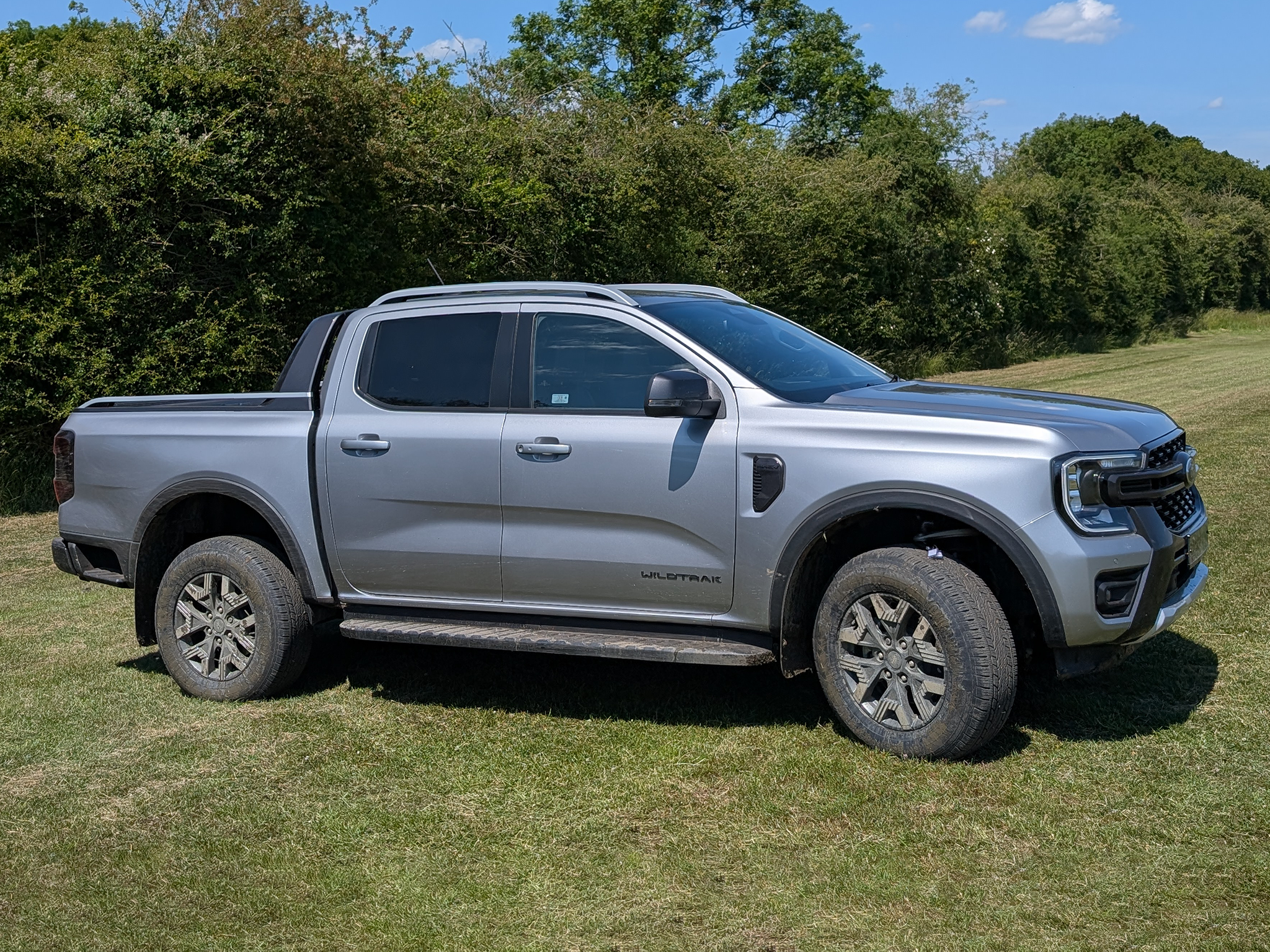
Whereas passenger cars and commercial van fleets are rapidly electrifying, the pick-up might just be the last holdout in the transition to EVs – especially in the UK.
The Ford F-150 Lightning proved that electric trucks are possible in a country that pays little attention to weight limitations, but the fully electric version of the most popular car in America is simply too massive for our roads. The Tesla Cybertruck is plainly silly and about as road legal in the UK as a skip full of knives. Your only option for an EV hauler in the UK, the Maxus T90 is an honest-to-goodness electric pick-up, albeit with asthmatic towing ability.
So it makes sense that Ford has taken only a cautious half-step towards electrifying the hugely popular Ford Ranger. The plug-in hybrid edition of the truck adds a 75kW electric motor, a modular hybrid transmission and a 11.8kWh battery to its 2.3 litre EcoBoost engine. The changes add just a 31mm rise to the Ranger’s bed – besides the extra flap for charging and a few PHEV details around the air vents, you’d barely notice the difference.
Ford’s goal was to add plug-in electric capability without changing the Ranger’s most sacred attributes, reducing emissions, lowering running costs and improving comfort, while leaving untouched its all-round utility as a commercial workhorse.
How we tested
We’ve had multiple test drives of the Ranger PHEV ahead of its launch, experiencing its performance and efficiency on-road, including motorways and country lanes, as well as its impressive capability on a demanding off-road course.
Ford Ranger PHEV: From £39,500, Ford.co.uk

Independent rating: 8/10
- Pros: Lots of torque, 3.5 tonne towing, ProPower three-pin power on board
- Cons: Short electric-only range, no fast charging
Ford Ranger PHEV specs
- Price range: £39,500 to £50,000
- Battery size: 11.8kWh
- Maximum EV range: 25 miles
- Engine: 2.3 litre EcoBoost
Battery, range, charging, performance and drive
The Ranger PHEV combines the 2.3 litre EcoBoost petrol engine seen in the Focus RS and Mustang with a 75kW electric motor fed by an 11.8kWh battery. This results in an impressive 700Nm of torque – the highest of any production Ranger ever – and retains the pick-up’s load-hauling capability.
The instant torque and regenerative braking of the electric motor help out in the field too, where off-road and low-speed handling feel sharpened. We crawled the Ranger PHEV up and down some steep, rocky inclines in full EV mode, where the e-4WD system constantly juggled torque distribution to keep the truck moving over challenging terrain. All of the Ranger’s usual off-road systems are here and have been tweaked to play nice with the new transmission – features like automatic hill descent and rear differential lock should get you out of most sticky situations under electric power alone.
Back on the road the Ranger PHEV offers a sturdy, comfortable ride and a typical high-up driving position that gives great visibility all round. The pick-up is surprisingly agile for its size and weight too, ducking around tight bends with composure. Four EV modes determine how much electric power you want to use – or reserve to use at your destination – with the default Auto EV setting striking a balance between engine performance and electric motor efficiency.
Electric-only range is just 25 miles. That’s weak by PHEV standards, but still enough mileage for short trips and occasions where you might want to avoid belching fumes out of the tailpipe – like visiting campsites and worksites, or entering low-emission urban zones. There’s no fast charging here – just a standard AC socket.

Interior, practicality and boot space
Inside, the Ranger PHEV largely echoes the familiar cabin of the current Ranger. Durable hard plastics are used throughout, but the interior is functional enough for a working vehicle, with surprisingly comfy seats in the front – you can opt for heated seats, too – and decent legroom for two passengers in the back.
Driving modes, EV modes and off-road systems all get physical controls on the centre console next to the chunky gear selector, as do some climate controls and other essential functions beneath the display. The highest trim levels get a few splashes of colour and detailing around the cabin to match the car’s paint.
The 11.8kWh battery is packaged in the pick-up bed, resulting in only a 31mm rise, so capacity is pretty much unaffected. You have the option to add a powered canopy and a sliding sports rack for securing ladders and other awkward loads, while the easy lift tailgate and cargo lighting make accessing the bed straightforward. Built-in floodlights can illuminate areas around the car for better visibility when working after dark, too.
Technology, stereo and infotainment
Beyond the hybrid system itself, the Ranger PHEV doesn’t go overboard with fancy tech, keeping things relatively modest with a vertical 12in touchscreen in the centre of the dash and an 8in driver display behind the wheel. A 10-speaker B&O audio system is available on the launch edition Stormtrak trim, which sounds decent enough for a utility vehicle, and the cabin gets a degree of active noise cancellation to reduce road and wind sounds at speed.
The smartest new tech on board the Ranger PHEV is Ford’s Pro Power Onboard system, a plug socket in the bed that effectively turns the pick-up into a mobile power source capable of running everything from heavy-duty appliances to a Nespresso machine. One of the EV driving modes is designed to conserve the battery for use at your destination too, so you can arrive confident that your car will have enough power to make you a coffee.
As well as the usual set of standard driving assists like lane-keeping and pre-collision assist, you have the option to add Pro Trailer Backup Assist, which automatically moves the pick-up into position for towing and uses the 12in display to help manage awkward manoeuvres with trailers. Similarly, the front camera helps with wheel positioning when driving off-road or along dirt tracks.

Prices and running costs
The Ford Ranger PHEV starts at £39,500 (ex. VAT) for the entry-level XLT, rising to around £45,000 for the Wildtrak and around £50,000 for the limited-edition Stormtrak. While pricier than the diesel equivalents, the long-term savings and tax advantages are compelling, especially for commercial users.
As a plug-in hybrid, the Range PHEV benefits from being more fuel efficient, but it’s the car’s lower CO2 emissions that produce the biggest immediate savings by slashing benefit-in-kind tax for company car users. Ford also projects £2,250 savings on maintenance over conventional models and potential fuel savings of £1,000 per year for those utilising cheap overnight electricity tariffs.
Rivals
- Maxus T90
- Ford Ranger (diesel)
- Ford E-Transit Custom
FAQs
How long does it take to charge?
With no fast charging to speak of, the 11.8kW battery on the Ranger PHEV will charge in around a couple of hours from a 7kW home charger.
How much does it cost, and is it worth it?
There’s a small premium to pay versus the petrol and diesel Ranger, but this is offset by cheaper running costs. Overall fuel efficiency and a reduced tax liability for company fleets quickly adds up to decent savings.
What should I look out for before buying one?
Consider if the limited electric-only range meets your daily needs for EV driving and ensure the higher upfront cost is offset by your potential tax and running cost savings, especially if you can regularly charge it on a cheap tariff.
Why trust us
Our team of motoring experts have decades of experience driving, reviewing and reporting on the latest EV cars, and our verdicts are reached with every kind of driver in mind. We thoroughly test drive every car we recommend, so you can be sure our verdicts are honest, unbiased and authentic.
The verdict: Ford Ranger PHEV
Ford has electrified the Ranger without compromising its workhorse soul, delivering an upgrade with impressive torque and range-topping fuel efficiency alongside a few compelling extras like ProPower. Limited EV range makes the Ranger PHEV a little less versatile, but the tax savings alone will make it a hit with business users.
Best long-range electric cars 2025: Top 11 EVs that go the distance
Think electric cars are expensive? My new EV costs me less than a couple of posh coffees a day
Best electric cars 2025: Top 10 EVs to buy and the ones to avoid
Jaecoo 7 review: Great value plug-in hybrid, plagued by warning beeps
New Nissan Leaf: The OG EV is back and it’s built in Britain
BYD’s new EV chargers are as fast as petrol pumps – here’s when they’re coming to the UK
BYD Dolphin Surf review: Is this what a budget Tesla should be like?







